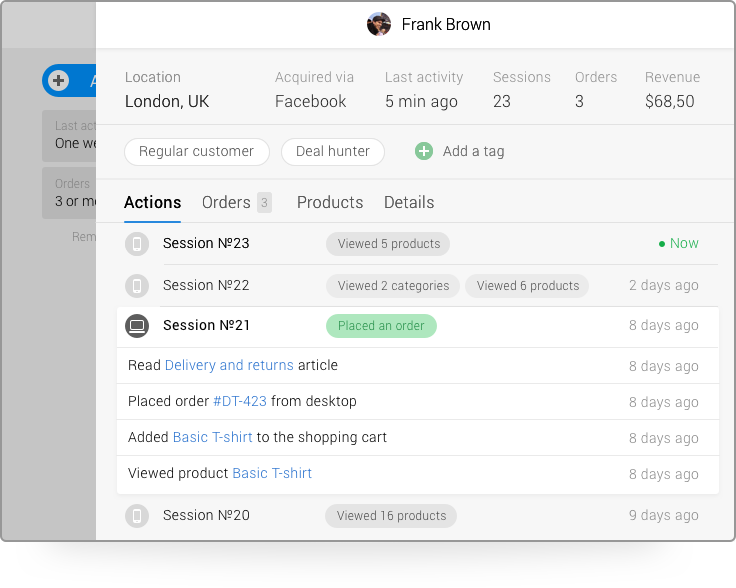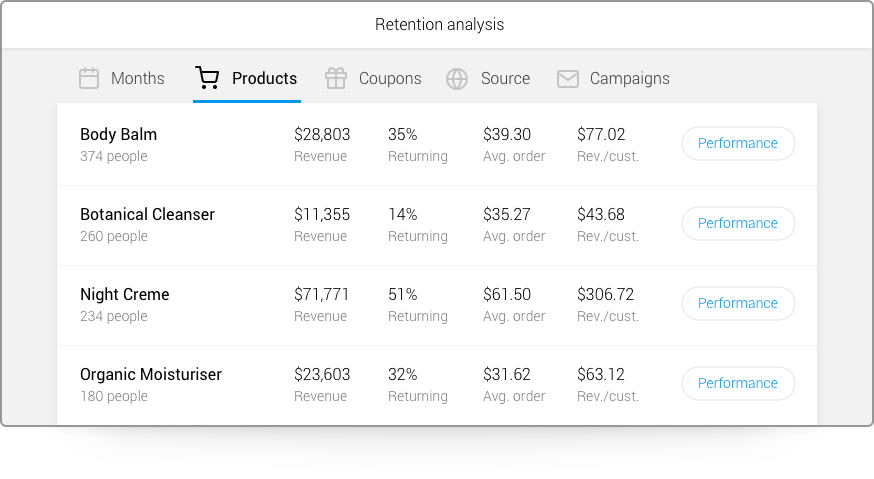DTC brands today have one incredible advantage over legacy companies who are just beginning to recognise the power of data. Brands, born online, own the entire customer journey from awareness to long-term customer retention and are able to control it. How? Because they have all the data about it on their fingertips – first-party data.
The power of first-party data
First-party data is priceless because you own it, nobody else has access to it and you are free to use it to drive your business forward. It is the data you collect off your users directly just as they use your site. They consent to giving you this data for the sake of interaction – and they expect you’ll use it. And there is no guesswork involved – people did that in direct relation with your brand.
What is first-party data?
- Sales and marketing stats
- Product performance – best selling, best converting, products with most repeat orders, products bringing most loyal customers, products frequently bought together, etc.
- Acquisition channel performance – traffic, conversions and revenue by channels and partners
- Customer database – contacts, details, tracked behaviour over time, interactions on site, campaign engagements, content consumed, coupons used, order history, acquisition source, average order value, lifetime value, any other behaviors on site, etc.
- Feedback – qualitative and quantitative, coupled with the products that prompted it.
- Email data – aggregated stats plus individual customer response to each email.
All actions a customer has taken on your site, an example of first-party data invaluable for marketing (Source: Metrilo CRM)
Other types of data are second-party and third-party. Second-party is the same as first-party, but for some other company and you can pay or agree on terms to use it. An example would be an exchange of customer lists between two DTC brands as a form of partnership. Third-party data is your target audience’s interactions with other sites and assumptions about their buying behavior, gathered by cookies, surveys and social media. Its problems include:
- Third-party data is anonymised and aggregated.
- Assumptions about target groups are broad and extrapolated.
- You have to buy this data to use it.
- Its use is often limited to the platform where it was gathered, e.g. Facebook.
- It is also available to your competitors.
- People don’t know where you got this information on them and feel uneasy when you use it, especially with GDPR.
And what other sites people visited is not really relevant. In 21 century we all browse countless websites both for work and for leisure – do they all matter? Do they all impact the buying decision we take on each one? We as marketers have been overestimating the power of third-party data while overlooking what we already have freely and in abundance: first-party data.
First-party data is your competitive advantage that no-one else can use.
First-party data DTC brands own and don’t share with anyone
The best thing about first-party data is that you own it and no-one else can use it to their benefit. Of course, if your competitors had access to it, they’d see how you’re doing in terms of sales and marketing. They could also steal your contact list and try to win your customer over. They could copy your best campaigns and products. But they don’t have the deeper understanding of the shopping behavior and relationship with the brand.
Most importantly, all this data lets you connect the dots about how people experience your brand and how they shop from you. Then, you are able to guide this experience and make it even better. That’s an advantage your competitors cannot steal. It’s in your hands to use.
Ways to use first-party data
Now that you realise what invaluable data you have, let’s see how you can use it to drive sales.
Tailored product promotions
How people browse and shop your products is a huge insight. The fine-tuned experience you can create based on this data cannot be replicated by any competitor.
- Use as headliners the products that convert best or that bring the most loyal customers.
- Promote those products that get most repeat orders – they can be your go-to follow-up offer.
- Bundle up products frequently bought together.
- Segment customers by categories of interest and send them only relevant product offers, cross-sells and upsells.
- Tailor nurturing between orders as well: send targeted content based on displayed interest to engage customers with exciting information.
Product correlations data (Source: Metrilo product report)
Targeting specific behaviours
With behavior tracking on your site, you would know how people shop and engage with your brand. This means you can direct their journeys for even more conversions and higher loyalty. Set up email automation campaigns or simply follow up when people do certain things on your site to engage them on time and relevantly.
- Fight browse abandonment with remarketing the products they viewed.
- Send more articles when they read your blog.
- Tag by taste or preference based on the product category they shop to deliver more targeted offers.
- Give your customers more of what they like. If they use coupons, send them some again. If they return items often, reach out when they place a new order and make sure it is what they want.
- Act on feedback: thank people for the positive reviews and follow up with unhappy customers to resolve the issue. Also, improve the products that get you bad reviews.
- If you see people open and read your emails about brand values, raw materials and story, maybe it’s a good idea to add all this information on the site to help conversions.
Differentiating campaigns
Once you trust your data, marketing becomes easier. There’s no need to search for endlessly new ideas. It’s all in your e-commerce analytics and CRM.
- When you know how often and what people buy (the most basic first-party data you have), you can send perfectly-timed reorder reminders when people are running low on the product.
- To increase the average order value, offer freebies or gifts to customers if they add a bit more to their order.
- Offer premium experience for VIP customers. Segment them by metrics like customer lifetime value or order count and send them special offers or ask for input on new products. Anything to keep them engaged, happy and referring friends!
- Use the acquisition data to segment customers and reach them on the platforms they like best.
- Send post-purchase emails with useful information about the specific product bought. This will stimulate the use of the product and the customer satisfaction with it, leading to new orders.
Customer segmentation and tagging for tailored offers (Source: Metrilo CRM)
Optimising budgets and offers
Your first-party data tells you which of your campaigns and offers work. Use this data to optimise your marketing spending, betting more on what works and dropping what doesn’t.
- Allocate more marketing money to marketing channels that bring not just more conversions, but also more repeat customers.
- Compare how influencers and referrals sources are doing to keep the good ones as long-term partners.
- Optimise your product range, dropping the products that don’t drive customer loyalty.
- Repeat the promotions with best results – maybe it’s a particular type of coupon or messaging.
Customer retention by product: which products bring loyal customers (Source: Metrilo retention report)
Conclusion
First-party data basically allows you to do all the personalised and relevant marketing you need without the negatives. People know where you have this data and are fine with you using it. The marketing done this way is tailored without being creepy or intrusive. And saves you money because you don’t need to buy third-party lists.
Guest author bio:
Murry Ivanoff: CEO of Metrilo
Murry Ivanoff believes DTC is the future of commerce and he created Metrilo to help such brands compete with big corporations and succeed. Metrilo combines e-commerce analytics, CRM, and email marketing, making customer insights and behaviors usable for building long-term relationships. Metrilo helps brands grow profitably thanks to customer retention.





















